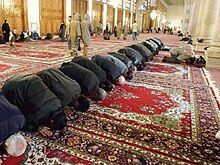Bowing
Bowing (also called stooping) is the act of lowering the torso and head as a social gesture in direction to another person or symbol.
Sometimes the gesture may be limited to lowering the head such as in Indonesia, and in many cultures several degrees of the lowness of the bow are distinguished and regarded as appropriate for different circumstances.
It is especially prominent in Nepal, India, Cambodia, Thailand, Laos, Vietnam, China, Korea, and Japan, where it may be executed standing or kneeling.
Typically, while executing such a bow, the man's right hand is pressed horizontally across the abdomen while the left is held out from the body.
[2] Bows are the traditional greeting in East Asia, particularly in Japan, Korea, Hong Kong, China and Vietnam.
The kowtow is the highest sign of reverence in Han Chinese culture, but its use has become extremely rare since the collapse of Imperial China.
A gesture known as the Añjali Mudrā is used as a sign of respect and greeting and involves a bow of varying degrees depending on whom one performs it to and hands pressed together generally at chest level.
[14] Gestures across the region are known by different names such as the sampeah in Cambodia, wai in Thailand,, sembah in Indonesia, namaste in India and Nepal, and in Sri Lanka the gesture is used as a greeting with the word "Ayubowan" In many Eastern religions bowing is used as a sign of respect in worship and has its origins in the Indian "Añjali Mudrā".
Visitors to a Shinto shrine will clap or ring a bell to attract the attention of the enshrined deity, clasp the hands in prayer, and then bow.
[citation needed] In the Hindu traditions people show deference by bowing or kneeling down and touching feet of an elder or respected person.
Traditionally, a child is expected to bow down to their parents, teachers and elders during certain formal ceremonies and casual settings.
During the concluding Aleinu section of the services, congregants usually bow when they say "V'anachnu kor'im u'mishtachavim u'modim," meaning "we bend our knees, prostrate, and acknowledge our thanks."
[15] Kneeling is retained in modern Orthodox Judaism, but only on the High Holy Days — once on each day of Rosh Hashanah (when the Aleinu prayer is recited during the Amidah), and four times on Yom Kippur — again, once for Aleinu, and three times during a central portion of the service when the details of the Avodah, the High Priest's service in the Temple are recited.
The Talmudic texts as well as writings of Gaonim and Rishonim indicate that total prostration was common among many Jewish communities until some point during the Middle Ages.
"[16] The eighteenth canon of the Church of England, mother Church of the Anglican Communion, made this external obeisance obligatory during the divine service, declaring: "When in time of divine service the Lord JESUS shall be mentioned, due and lowly reverence shall be done by all persons present, as it has been accustomed; testifying by these outward ceremonies and gestures their inward humility, Christian resolution, and due acknowledgement that the Lord JESUS CHRIST, the true eternal Son of God, is the only Saviour of the world, in whom alone all the mercies, graces, and promises of God to mankind for this life, and the life to come, are fully and wholly comprised.
In many Christian denominations, individuals will bow when passing in front of the altar, or at certain points in the service (for example, when the name of Jesus Christ is spoken, as mentioned above).
[25] Conservative Protestant Christians such as Brethren, Mennonite, and Seventh-day Adventists make a practice of kneeling during community prayer in the church service.


